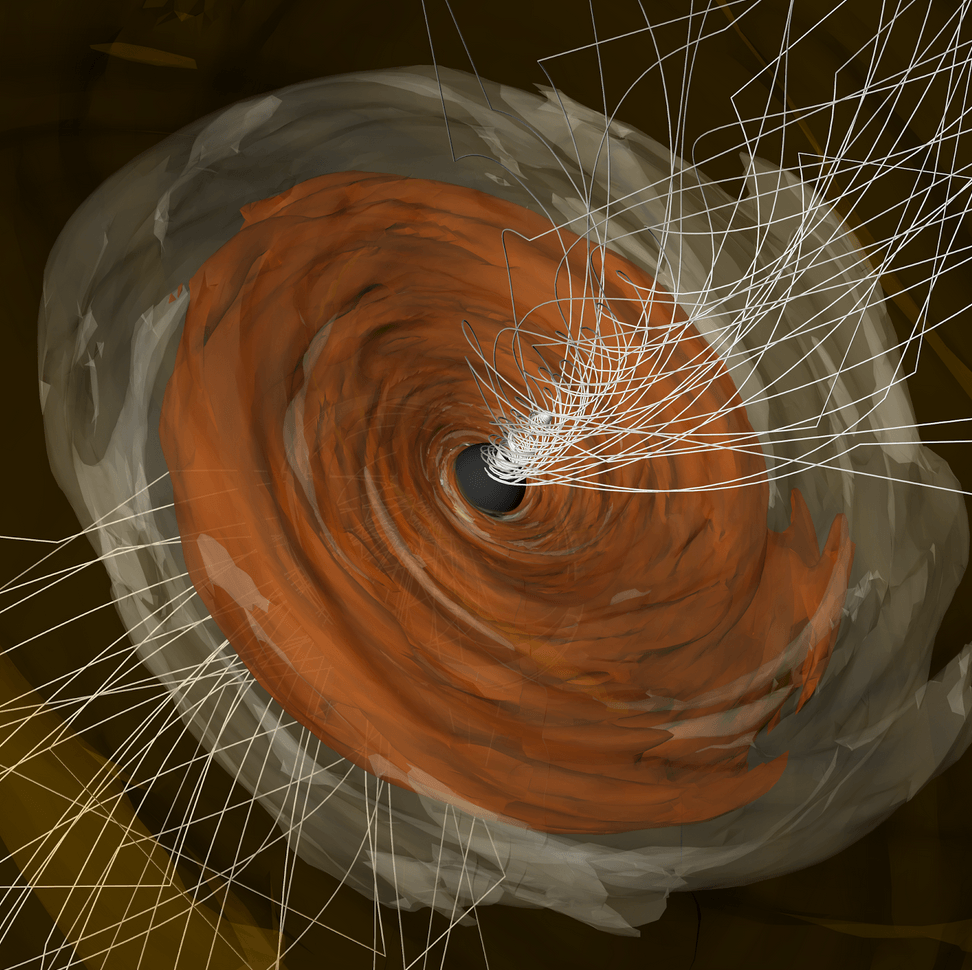When the EHT’s first images of M87* were released in 2019, they offered a stunning close-up of a supermassive black hole like we’ve never seen before. But there are more details hidden in the data, and members of the EHT collaboration have been working hard to tease out every ounce of information they can.
In 2021, for example, they measured the ‘linear polarization’ of light coming from the black hole, providing information about the direction and magnitude of oscillations in the electric field. Polarization is the same effect that sunglasses take advantage of to block the sun’s rays, and polarimetric measurements are one way of detecting and mapping electromagnetic fields. Measuring the linear polarization of light from M87* helped confirm that the magnetic fields around the black hole were very strong, and were structured in an ordered fashion.
Today, the EHT released their latest results, studying the circular polarization of light coming from the black hole.
“Circular polarization is a cousin of linear polarization in which the electric field twists around instead of oscillating in a single plane,” says Avery Broderick, a member of the EHT collaboration and an associate faculty member at Perimeter Institute and the University of Waterloo.
That spiralling light is immensely useful. It can impart information about the structure of the magnetic field and the particles responsible for generating the radio emissions that the EHT observes, says Broderick.
However, it is also incredibly faint.
“Circular polarization is the final signal we looked for in the EHT’s first observations of the M87 black hole, and it was by far the hardest to analyze,” says Andrew Chael, an associate research scholar at the Gravity Initiative at Princeton University, who coordinated the project. “These new results give us confidence that our picture of a strong magnetic field permeating the hot gas surrounding the black hole is the right one. The unprecedented EHT observations are allowing us to answer long-standing questions about how black holes consume matter and launch jets outside their host galaxies."
Getting these results wasn’t easy. The circular polarization signal makes up just a tiny fraction of the total light received by the EHT’s network of telescopes: it was very nearly drowned out by the noisy mess of emissions that come from the region around the black hole.
Because of the weakness of the signal, the chaotic environment around the black hole, and uncertainties regarding the performance of the EHT instruments back when data was first captured in 2017, exact measurements of the circular polarization aren’t possible right now, not without further observations. But the EHT team were able to put upper limits on the level of circular polarization in the image, placing it at less than 3.7% of the total light.
“At less than 4 parts in a hundred, finding the circular polarization signal is like hearing a whisper across a crowded room. It was a monumental challenge,” says Broderick.
“Because the circular polarization signal was so weak, looking for it required a careful examination and treatment of all sources of instrumental error. A new technique, pioneered here in Waterloo, provided rigorous measures of the credibility and reliability of any measurement, and resulted in the upper limits reported here.”
That technique is a method of polarimetric imaging that not only reconstructs an image, but also estimates the probability of various image features. Without it, recovering an upper limit would not have been possible.
And that upper limit is valuable information.
Even without a detection and a clear confirmation of the ‘handedness’ of the polarization (whether it spirals clockwise or counterclockwise), the EHT team were able to use the upper limit to constrain the behaviour of M87*’s accretion disk. The data adds to evidence for strong ordered magnetic fields at the event horizon of M87*, and helps explain how matter can be launched from near the black hole in the form of a powerful jet.
Though it is the final M87* signal to be gleaned from the now historic 2017 EHT observing campaign, this is only the first foray into mapping the circular polarization on horizon-scales. In the last six years, the EHT has added new telescopes to its global network and grown in sensitivity – advances that will soon make it possible to fully map the magnetic structures that surround gravity’s most extreme objects.
More Information
The EHT collaboration involves more than 300 researchers from Africa, Asia, Europe, and North and South America. The international collaboration is working to capture the most detailed black hole images ever obtained by creating a virtual Earth-sized telescope. Supported by considerable international investment, the EHT links existing telescopes using novel systems, creating a fundamentally new instrument with the highest angular resolving power that has yet been achieved.
The individual telescopes involved are: ALMA, APEX, the IRAM 30-meter Telescope, the IRAM NOEMA Observatory, the James Clerk Maxwell Telescope (JCMT), the Large Millimeter Telescope (LMT), the Submillimeter Array (SMA), the Submillimeter Telescope (SMT), the South Pole Telescope (SPT), the Kitt Peak Telescope, and the Greenland Telescope (GLT).
The EHT consortium consists of 13 stakeholder institutes: the Academia Sinica Institute of Astronomy and Astrophysics, the University of Arizona, the University of Chicago, the East Asian Observatory, Goethe-Universitaet Frankfurt, Institut de Radioastronomie Millimétrique, Large Millimeter Telescope, Max Planck Institute for Radio Astronomy, MIT Haystack Observatory, National Astronomical Observatory of Japan, Perimeter Institute for Theoretical Physics, Radboud University, and the Smithsonian Astrophysical Observatory.
About PI
Perimeter Institute is the world’s largest research hub devoted to theoretical physics. The independent Institute was founded in 1999 to foster breakthroughs in the fundamental understanding of our universe, from the smallest particles to the entire cosmos. Research at Perimeter is motivated by the understanding that fundamental science advances human knowledge and catalyzes innovation, and that today’s theoretical physics is tomorrow’s technology. Located in the Region of Waterloo, the not-for-profit Institute is a unique public-private endeavour, including the Governments of Ontario and Canada, that enables cutting-edge research, trains the next generation of scientific pioneers, and shares the power of physics through award-winning educational outreach and public engagement.
You might be interested in



